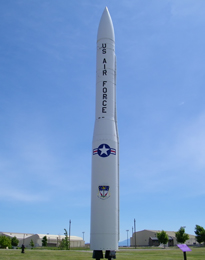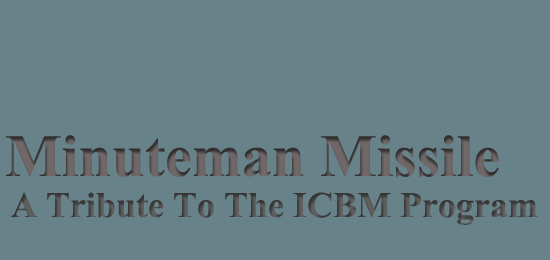
Sentinel Missile - Artist Concept
Ground Based Strategic Deterrent
The Ground Based Strategic Deterrent program, GBSD, was created by the Air Force for the purpose of developing the next generation ICBM.
The current ICBM, the Minuteman III missile, presently on strategic alert at FE Warren, Minot and Malmstrom Air Force bases, was first deployed in 1970. Since that time the Minuteman III has seen a number of Life Extension programs implemented, to assure that the MMIII missile will be viable until 2030. Given that the Minuteman missile is coming to its end of use, prompted the creation of the Ground Based Strategic Deterrent program.
On July 29, 2016 the Air Force released a request for proposal to develop what was then called the Ground Based Strike Deterent missile. The Air Force released a statement April 5, 2022 reporting that the new GBSD missile will be called the Sentinel missile.
Sentinel Missile Information
Given that the Sentinel missile program is still in its early stages of development, this website's author has only preliminary information regarding this program. The author feels that given the significance of this program, the information that has been released thus far will be made available here on this site. As new information becomes available, it will be added here accordingly.
The Sentinel missile program was created by the Air Force to design, develop and deploy a new generation ICBM that includes launch and command and control structures. Much has changed in terms of the technology and defensive measures currently used in the ICBM weapon system currently on strategic alert. The Air Force understands the necessity to evolve in meeting current, as well as unknown future threats, regarding the ICBMs that make up the nuclear deterrent force, here in the United States.
On July 29, 2016, the Air Force solicited contract proposals from the industry to replace the Minuteman III missile and its weapon system. Lockheed Martin, Boeing, and Northrop Grumman were the 3 companies who submitted proposals. On August 21, 2017 the Air Force announced that it was giving the two Technology Maturation and Risk Reduction, TMRR, contracts to Boeing and Northrop Grumman. These two companies had until 2020 to submit their design for the new Sentinel missile, at which time the Air Force will determine which proposal will fit their requirements. Durng early stages of development, the Sentinel missile has a target of deployment by 2030. That target date has since shifted to 2032.
In July, 2019, Boeing backed out of their submission for a contract proposal to the Air Force, leaving Northrop Grumman the remaining company submiting their proposal for a contract with the Air Force.
On September 8, 2020 the Air Force awarded Northrop Grumman the contract to develop the new GBSD - Sentinel missile.
In 2016 the Air Force estimated this program would cost approximately $62.3 billion for the new missile, consisting of a total of 400 Sentinel missiles for deployment, and additional missiles to allow for testing and launch research. In response to the 2016 estimate given by the Air Force, the Department of Defense has stated that their Cost Assessment and Program Evaluation office, CAPE, are stating an estimate of closer to $85 billion dollars for the new GBSD system.
Of interest to the reader, is an article published in the February 2018 Air Force Magazine, titled, "Replacing Minuteman." It discusses a number of factors pertinent to the new GBSD program, and what the Air Force is already considering and making known to both Boeing and Northrop Grumman, in their preparation for their proposals for GBSD. Click on the link below to read this article.
As stated in the article, the Air Force has determined that they will be able to continue to use the current Launch Facilities that house the 400 deployed Minuteman III missiles, located at FE Warren, Minot and Malmstrom Air Force Base. In realizing that the cost of the developing and constructing 400 to 450 new Launch Facilities would be extremely expensive. Through analysis of the current Launch Facilities, it was determined that these missile silos are still solid, and can be used with the new GBSD.
It is important to note, that with the programmed depot maintenance that began on all of the 450 Launch Facilities at the three missile wings, has allowed the Air Force to place 50 of these launch facilities into what some have termed these Launch Facilites as "warm silos". The depot maintenance started in 2017. Each missile wing has been removing the entire Minuteman missile from 17 of their Launch Facilities, and performing thorough maintenance and renovation of these Launch Facilities. Once completed, they return the missile back to the LF, and start maintenance on the next Launch Facility slated for the depot maintenance of that respective missile wing.
This is providing the Air Force a means to be in compliance with the New START treaty - having 400 Minuteman missiles, down from 450, but allowing the Air Force to maintain the 50 empty Launch Facilities in a "warm silo" status. It also allows the Air Force the much needed thorough maintenance on these Launch Facilities, some of which have been on strategic alert since 1962.
Once the GBSD program has designed and built the new generation ICBM, the Air Force will be able to utilize these up to spec Launch Facilities to house and place on strategic alert the new GBSD missiles.
Another essential feature for the new generation ICBM was discussed in the article mentioned above, which outlined the importance of building an "open system" with this new ICBM. Given the scenario that one part of the new GBSD missle needs to be updated, or outright replaced with an improved component, say the guidance system, it will be crucial that by designing and installing a new component into the new GBSD missile, this component will not have a proprietary feature to it. This will allow for a more efficient, as well as cost effective feature, that will eliminate the need to replace an entire system, and will allow for just that one new component to be installed seamlessly with the rest of the missile.
Sentinel Missile - Table Of Contents
On the following page you will find information divided into the respective sections that discuss various features of the upcoming Sentinel missile.
Click on the link below to review the table of contents regarding the Sentinel missile.

